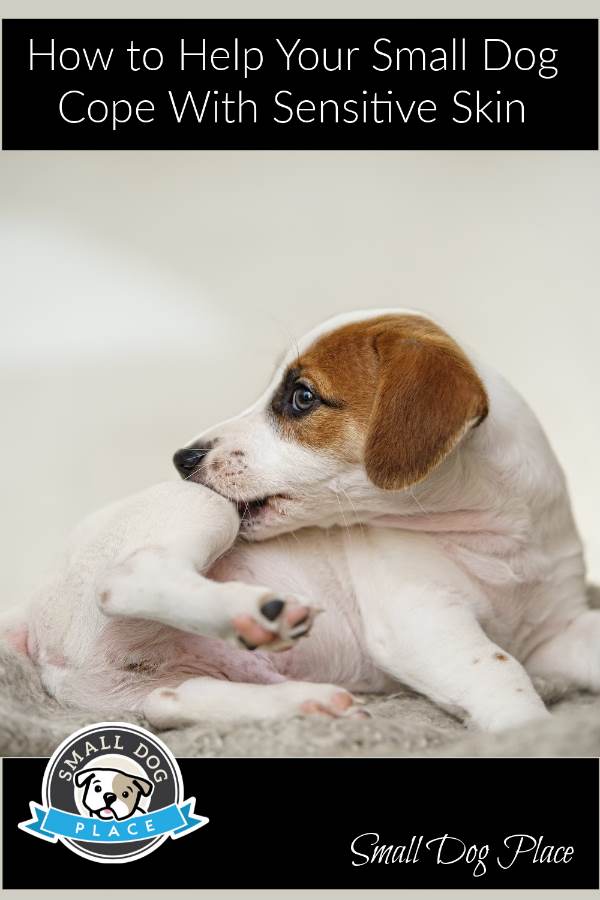- Small Dog Place Home
- Health
- Sensitive Skin
How to Help Your Small Dog Cope With Sensitive Skin
Sensitive Skin by Frankie Wallace
As a small dog owner, you might fall into the stereotype of spoiling your four-legged baby. Maybe you give in to everything they want or carry them around with you wherever you go. Guilty? Hey, we’re definitely not judging.
The reality is, many people consider their dogs to be part of the family. So, it’s perfectly understandable to want to take care of them in every way. Unfortunately, some things aren’t always under your control when it comes to your pet – including sensitive skin.
 Help Your Small Dog Cope With Sensitive Skin
Help Your Small Dog Cope With Sensitive SkinIf your dog already has sensitive skin and develops allergies or another condition, it could cause them to become extremely uncomfortable. It might also cause them to scratch excessively, which could lead to even bigger (and more dangerous) problems.
Let’s talk about some of the potential causes for sensitive skin as well as what you should look for. We’ll also cover what you can do to help your small dog find relief, even around irritants.
What Causes Sensitive Skin in Small Dogs?
When you have a better idea of what’s triggering your dog’s sensitive skin, you’ll be able to develop a better management plan for them.
There are different factors to consider, including environmental and genetic. Some of the genetic factors could be allergies or your dog’s diet. Some dogs are just more prone than others to specific allergens in the air, or even in food.
Recognizing food allergies is extremely important because skin irritation might only be one symptom. Dogs that are allergic to certain ingredients can experience anything from vomiting and diarrhea to permanent paralysis.
Environmental factors that can contribute to sensitive skin in dogs include:
- Dry air (indoor or outdoor)
- Seasonal changes
- Parasites
Things that irritate your skin as a human can also have an impact on your dog. Substances around your house like certain cleaners or soaps, or even certain perfumes can cause problems.
Substances like asbestos are extremely risky, too. If your house was built before 1970, asbestos exposure can cause your dog to develop itchy rashes on their skin, but it could also be impacting their lung health – as well as your own.
What Are the Signs of Sensitive Skin?
The most obvious sign of sensitive skin on a dog is scratching. Every dog itches from time to time.
They’ll also lick, chew, and even occasionally “bite” themselves to relieve an itch or hit the “right spot”. While those actions are typically no cause for concern, when they’re done in excess they could be dangerous.
Sometimes, it might not just be caused by sensitive skin. Your dog could be in pain or struggling with anxiety.
So, it’s important to narrow down what’s actually going on. Some of the other signs of sensitive skin include:
- Increased hair loss
- Dry or flaky patches of skin
- Red or inflamed skin
- Itchy ears
Hives or red bumps are also common on the skin if your dog is experiencing an allergic reaction. If that’s the case, get them to their veterinarian as quickly as possible.
But, if you think your dog is just dealing with everyday skin irritation, it’s not an emergency.
Still, that’s your baby, and you want to make sure you’re doing whatever it takes to make them feel comfortable. So, what can you do?
Treating Your Small Dog’s Sensitive Skin
No matter how pampered your pup might be, they’re not going to sign up for a spa day all by themselves. So, it’s up to you to find soothing ways to treat their sensitive skin. It starts with basic grooming.
If you bathe your dog yourself, use a shampoo specifically meant for sensitive skin, like an oatmeal-based solution. That will help to exfoliate your dog’s skin without irritating it.
If you don’t want to groom your dog on your own, choose an experienced groomer who knows how to handle specific skin conditions and can get your furry friend’s coat and skin in great condition.
Develop a positive relationship with your dog’s groomer, and don’t be afraid to ask questions. Experienced groomers typically see dogs with a variety of skin conditions, and they might be able to give you additional tips and suggestions to try at home.
Other treatments you can use including rubbing Vitamin E over any irritated patches of skin on your dog, changing their diet, and wiping their feet after they’ve been outside.
Pollen and other irritants can build up on their paws and get into their skin, contributing to irritation.
Pin for Future Reference

Last Words
If you’re a pet owner who does everything possible for your four-legged family member, it’s easy to feel overwhelmed by sensitive skin issues you can’t control.
But, by getting to the underlying cause(s), making changes as necessary, and finding ways to help your small dog cope, you can alleviate any irritation associated with sensitive skin, and go back to pampering your pooch as much as possible.
Author Bio
Frankie Wallace is a frequent contributor to Small Dog Place. She is a freelance writer from Boise, ID. If her spirit animal could be anything, it would be a beagle--inquisitive, and always searching for food.
More Articles by Frankie Wallace
If you found this article helpful, check out other posts written by Frankie Wallace.
Small Dog Obesity: Your Dog Isn't Chunky--It's Obese
The Benefits and Challenges of Having Pets in the Workplace
How to Guide Your Senior Dog Into Aging with Ease
How A Dog Can Promote Healthy Living
How to Care for Dogs with Sensitive Stomachs
How small dogs help cancer patients: Having a Small Dog Can Boost Positivity for Cancer Patients
About Janice (author and voice behind this site)
Janice Jones has lived with dogs and cats for most of her life and worked as a veterinary technician for over a decade. She has also been a small-breed dog breeder and rescue advocate and holds academic training in psychology, biology, nursing, and mental health counseling. Her work focuses on helping dog owners make informed, responsible decisions rooted in experience, education, and compassion.
When not writing, reading, or researching dog-related topics, she likes to spend time with her six Shih Tzu dogs, her husband, and her family, as well as knitting and crocheting. She is also the voice behind Miracle Shih Tzu and Smart-Knit-Crocheting
Does This Article Deserve Your Thumbs Up?
We always appreciate your support and encouragement. Your thumbs up means so much to us. Please like this article.
If you find this page or any page on Small Dog Place Helpful, or useful in anyway, I'd love it if you would click the small heart found on the bottom right of each page.
You can also share or bookmark this page -- just click on the:

Free Monthly Newsletter
Sign Up for Our Free Newsletter and get our Free Gift to You.
my E-book, The Top 10 Mistakes People Make When Choosing a Dog (and how to avoid them)

